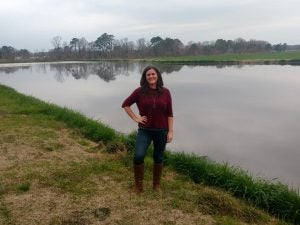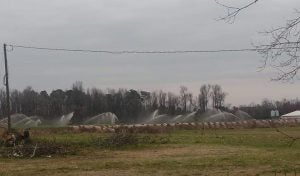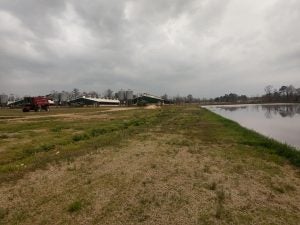Twitter is a powerful tool to connect to farmers. When asking questions in the “Twittersphere” about how glyphosate is used on wheat fields (hint: it usually isn’t), I received an overwhelmingly positive reaction of farmers who wanted to share their stories. Some of these farmers were in North Carolina, and we took it upon ourselves to take some farm tours!
Although the primary focus of the trip was wheat, a ton of knowledge about pig farming was shared as well since North Carolina is second in the U.S. for pork production. This has always interested me because of how so many people rail against “factory farming,” the environment, and other issues. But what are the real facts?
One pig farmer in particular, Joe Szaloky, was happy to show off his entire operation from wheat to pigs to manure management — and he explained it all.

Manure lagoons! On his North Carolina pig farm, Szaloky explained that waste flows by gravity into these large lagoons where the solids sink to the bottom. This farm’s lagoons cover about 3 acres, which serve around 3,675 hogs. A majority of what you see behind me is water and rainwater. The solids sink to the bottom, and it was interesting to experience the fact that there was minimal algae and zero bad smells! The water was clear enough to see turtles swimming about, and we also noticed ducks and other birds that choose to make these lagoons their habitat. Szaloky’s agronomist was with us on the tour, too, and pointed out the plant life around these lagoons: Do you notice all the healthy grasses on the perimeter? Sometimes there are myths out there about these manure lagoons being “toxic,” but if that were the case, we wouldn’t see healthy vegetation or animals living there.
What is your opinion of this photo?

Admittedly, I was a little weirded out by this at first with an untrained eye. This is called a solid set irrigation system, which is usually less labor and used in many industries from agriculture to sports, fire, mining, and other industrial uses. It may sound a little gross to think that this water comes from manure lagoons, however very little of this (about 1 percent to 5 percent, depending on sprinkler system) would actually be swine effluent (manure waste). This link from University of Nebraska explains:
“Manure irrigation is the process of applying liquid manure (effluent) to cropland through sprinkler irrigation. Because effluent is primarily water with a very small percentage of solids, it can be applied with sprinklers, such as traveling guns or center pivots. With pivots, special consideration must be taken to prevent clogging of sprinklers with the solids. Traveling guns have larger sprinklers, so they can accommodate up to approximately 5 percent solids whereas center pivots can only handle about 3 percent solids.”
Manure is commonly applied as a fertilizer for crops (pig manure has great nutrient value — many people would love to have a local source for liquid manure), and it’s perfectly safe when used according to guidelines.
Another question I had when visiting — how truthful are the stories about breached manure pits during Hurricane Florence? Media headlines swirled, but fake news traveled fast. According to the locals I spoke with, only one pit overflowed, and more than 98 percent of pig farms were not dangerously affected. Out of the 3,300 active hog lagoons in North Carolina, only six had structural damage. Images were “flooded” on the internet but many were taken out of context, mislabeled, or came from other countries or other storms. You can learn more about this in these highlighted links, including this one and this one. It certainly isn’t perfect and there’s always room for improvement, however the media isn’t always telling the true story.
It’s important to understand that farmers work with agronomists and waste-management operators to come up with a plan for nutrient management, which is heavily regulated by environmental groups (some affiliated with USDA and EPA) such as:
- North Carolina Department of Ag and Consumer Services, (NCDACS)
- North Carolina Department of Environmental Quality (DEQ)
- Department of Water Quality (DWQ)
At the end of the day, we all care about the environment, but farmers do especially since they invest so much time and money into doing things right — both from business and regulatory perspectives.

Back to the lagoon (with the pig barns in the back!). Required samples are taken every 60 days to measure PAN (plant available nitrogen) and other nutrients that show exactly how many gallons of water and nitrogen he needs on his fields, for example, for wheat, Bermudagrass for hay, or rye cover crops. Nutrients are extremely important for plant health, but it’s the law to apply manure (plant nutrients) responsibly. That’s why farms must comply with mandatory reviews and audits and notify the Department of Water Quality with their devolved plan of action.
In short, never judge a farm by its cover and always go straight to the source for information, such as up-to-date university research, or schedule a farm visit or ask the DEQ or EPA directly. Sometimes we can see scary click bait media headlines about “factory farms” (even though almost all U.S. farms are family owned and operated) not being good for the planet, but when you connect with farmers and their teams of environmental experts, you’ll oftentimes find the opposite is true. For more information, click the highlighted links above to connect with these resources.
Michelle Miller, the Farm Babe, is an Iowa-based farmer, public speaker, and writer, who lives and works with her boyfriend on their farm, which consists of row crops, beef cattle, and sheep. She believes education is key in bridging the gap between farmers and consumers.



